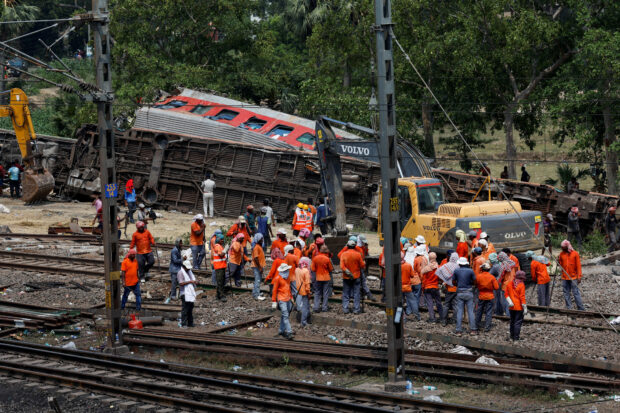
Heavy machinery removes damaged coaches from the railway tracks at the site of a train collision following the accident in Balasore district in the eastern state of Odisha, India, June 4, 2023. (REUTERS)
NEW DELHI – Investigators are probing an electronic track management system that they suspect malfunctioned and caused India’s deadliest train crash in more than two decades, railways officials said on Sunday.
At least 275 people were killed on Friday when a passenger train hit a stationary freight train, went off the tracks and hit another passenger train passing in the opposite direction in the eastern state of Odisha.
In their first detailed briefing on the crash, Indian Railways officials said that failure of the track management system was the main focus of investigations.
The computer-controlled track management system, called the “interlocking system”, directs a train to an empty track at the point where two tracks meet, Sandeep Mathur, principal executive director for signalling, told reporters.
It also coordinates and controls the signal to an oncoming train, indicating whether the train has to move straight or switch to a new track, he said.
“It is supposed to be tamper-proof, error-proof. It is called a fail-safe system, even if it fails the signal will turn red and the train will be stopped,” said Jaya Varma Sinha, a member of the Railway Board that runs the giant state monopoly.
“However, as it is being suspected, there was some kind of a problem in the system.”
Explaining the sequence of events that led to the crash at Bahanaga station in Balasore district, Sinha said the Coromandel Express heading to Chennai from Kolkata moved out of the main track, entered a loop track – a side track used to park trains – at a speed of 128 kph (80 mph) and crashed into a freight train carrying iron ore that was parked on the loop track.
The crash caused the engine and the first four or five coaches of the Coromandel Express to jump the tracks, topple and hit the last two coaches of the Yeshwantpur-Howrah train heading in the opposite direction on the second main track, she said.
The interlocking system should not have allowed the Coromandel Express to take the loop track, Sinha said.
She said she had spoken to the injured driver of that train and he had told her that he was within the speed limit and had not jumped a signal and all of this would be verified by systems that record track and train details, she said.
She did not name the driver.
There are many “possibilities of what can go wrong,”, Sinha said.
This could include someone digging in the area through which cables of the electronic system pass and damaging them in the process, or a short-circuit, or a machine failing.
“99.9% there is no possibility of the machine failing but there is a 0.1% chance of failure,” she said. “That possibility is always there in all kinds of systems.”
She did not name the supplier or manufacturer, or the age of the system. But said it is in use across almost the entire Indian railway network.


